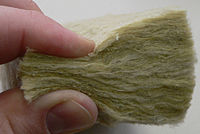
Photo from wikipedia
Abstract High-Temperature Insulation Wools (HTIW), such as alumino silicate wools (Refractory Ceramic Fibers) and Alkaline Earth Silicate wools, are used in high-temperature industries for thermal insulation. These materials have an… Click to show full abstract
Abstract High-Temperature Insulation Wools (HTIW), such as alumino silicate wools (Refractory Ceramic Fibers) and Alkaline Earth Silicate wools, are used in high-temperature industries for thermal insulation. These materials have an amorphous glass-like structure. In some applications, exposure to high temperatures causes devitrification resulting in the formation of crystalline species including crystalline silica. The formation of this potentially carcinogenic material raises safety concerns regarding after-use handling and disposal. This study aims to determine whether cristobalite formed in HTIW is bioactive in vitro. Mouse macrophage (J774A.1) and human alveolar epithelial (A549) cell lines were exposed to pristine HTIW of different compositions, and corresponding heat-treated samples. Cell death, cytokine release, and reactive oxygen species (ROS) formation were assessed in both cell types. Cell responses to aluminum lactate-coated fibers were assessed to determine if responses were caused by crystalline silica. DQ12 α-quartz was used as positive control, and TiO2 as negative control. HTIW did not induce cell death or intracellular ROS, and their ability to induce pro-inflammatory mediator release was low. In contrast, DQ12 induced cytotoxicity, a strong pro-inflammatory response and ROS generation. The modest pro-inflammatory mediator responses of HTIW did not always coincide with the formation of cristobalite in heated fibers; therefore, we cannot confirm that devitrification of HTIW results in bioactive cristobalite in vitro. In conclusion, the biological responses to HTIW observed were not attributable to a single physicochemical characteristic; instead, a combination of physicochemical characteristics (cristobalite content, fiber chemistry, dimensions and material solubility) appear to contribute to induction of cellular responses.
Journal Title: Inhalation Toxicology
Year Published: 2018
Link to full text (if available)
Share on Social Media: Sign Up to like & get
recommendations!